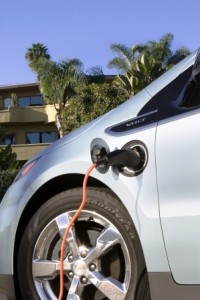Chevrolet announced this morning that the Washington D.C. area will be an initial launch market for the Chevrolet Volt electric vehicle. The nation’s political capital and its suburbs join California and Michigan as the initial retail markets where Chevrolet will sell the Volt to consumers, later this year.
Chevrolet also announced a development and demonstration program with D.C.-area utilities Pepco and Dominion to introduce customers to electric vehicles and establish vehicle-charging programs.
The company claimed in a statement that concentrating Volt sales in these three markets allows Chevrolet to concentrate on customer satisfaction. There are also geographical considerations, and the range of an electric vehicle can vary considerable by climate, topography and customer driving styles.
Chevrolet also said that “progressive” local and state government leaders and utility partners are crucial in bringing electric vehicles to market.”
Translation: Government Motors is staying close to the politicians who are underwriting it.
“The Chevrolet Volt demonstrates our commitment to the electrification of the automobile,” said Tom Stephens, GM vice chairman, Global Product Operations. “So far, we have invested more than $700 million in the U.S. to reinforce our leadership in this new technology.”
Taxpayers are providing massive subsidies to help overcome the objections of potential buyers for what are now and for the foreseeable future high cost, limited range electric vehicles, including tax credits of $7,500 per vehicle to purchasers, as well a variety of subsidized infrastructure changes.
Chevrolet also announced a development and demonstration program with D.C.-area utilities Pepco and Dominion to introduce customers to electric vehicles and establish vehicle-charging programs.
“Technology alone will not effect change,” said Joseph M. Rigby, Chairman and CEO of Pepco Holdings, Inc. “To fully achieve the benefits of the smart grid requires a partnership between utilities and customers, and consumer behavior that is responsive to price signals and incentives that will reduce usage, reduce emissions and lead us to energy independence.”
Rigby spoke at a news conference with GM officials at Pepco’s Edison Place garage on Eighth Street Northwest where two vehicle charging stations have been installed. Eight additional charging stations will be placed across PHI’s service areas in the District of Columbia, Maryland, Delaware and southern New Jersey when the company begins taking delivery of the Volts later this year.
Pepco no longer generates its own power, having sold its plants in 2000. It now distributes power generated by PJM, of which 40% comes from coal, 19% nuclear fission, 16% natural gas and 9% oil. Critics of EVs in the U.S. point out that most power is generated by carbon-based fuels so that there is no reduction of CO2 since EVs simply transfer emissions from the tailpipe to a smokestack.
Chevrolet will deliver more than 100 Volts to several utilities across the U.S. – including Pepco and Dominion, which serve Washington D.C. and its suburbs – as part of an extended demonstration program.
The program includes 500 charging stations that will be installed for residential, business and public use. They will be used to learn more about the installation process, vehicle charging and to gauge customer feedback.
The program is made possible with a grant of more than $30 million in American Recovery and Reinvestment Act funds from the Transportation Electrification Initiative administered by the U.S. Department of Energy. Chevrolet has announced similar partnerships with several utilities in California and Michigan, as well as the Electric Power Research Institute (EPRI).
The Chevrolet Volt is an electric vehicle with a large gasoline engine onboard to recharge the batteries. It is designed to drive up to 40 miles on electricity without using gasoline or producing tailpipe emissions, if you exclude how the electricity used to recharge its lithium ion battery pack is generated. Half of the electricity in the United States is produced by burning coal, a relatively dirty fuel that releases enormous amounts of CO2.
The utility and energy industries have apparently killed a proposed bill in the U.S. Senate that requires a CO2 “cap and trade” program, which was supposed to decrease their emissions of the most infamous of greenhouse gases, which EVs are said to reduce. Critics are pointing out the obvious contradiction.
This was before a Republican victory last week for Ted Kennedy’s Senate seat in Massachusetts that removed a filibuster proof majority from the Democratic party. Concentrating Volt sales in these three key initial markets allows us to give our first customers a high-quality experience,” said Jim Campbell, Chevrolet general manager. “In addition to geographical considerations, each market also has progressive local and state government leaders and utility partners who are crucial in bringing electric vehicles to market.”
Volt production begins later this year, and pricing has not been announced. The battery pack alone will add at least $10,000 to cost of the vehicle, which is widely predicted to be in the $40,000 range to customers before taxpayers provide relief.


I’m optimistic that battery prices will drop. Follow video recorders’ prices, for example. When introduced in 1956, they were hundreds of thousands of dollars ($50K then, plus inflation). When I bought one in 1979, I paid about $2000 ($900 then, plus inflation) and today, they’re about $50, if you can find one.
Mass production and innovation are our friends.
JM
I hope you are right.
A sizable number of consultants are saying the opposite.
I just toured a Li-ion battery production facility and will eventually get a story out. The good news here is that this is really the equivalent of making magnetic VCR tape from a process point of view. The bad news is that the Asians hold many patents for these batteries and make the equipment and are the only source for the raw materials.
That too can change.
Ken Zino, editor